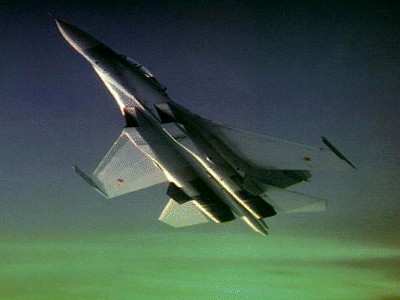Chairman Of Joint Chiefs On Goodwill Tour
In a move intended to foster openness between the two countries,
Chinese military officials let the chairman of the US Joint Chiefs
of Staff examine their country's top-of-the-line combat aircraft at
a Chinese air base this week, and allowed him to speak with pilots
and ground personnel.

Marine General Peter Pace and his party toured Anshan Air Base,
home of the Chinese People's Liberation Army Air Force's 1st Air
Division, and he examined a Chinese-built Su-27 fighter-bomber. The
base was part of a visit to the Shenyang Military Region.
The 1st Air Division has three flying regiments operating
Su-27s, F-8s and F-7Es. The Su-27 is the top of the food chain for
the PLA Air Force, and Pace was the first American to get such a
close look at the aircraft, senior Chinese officials said.
NATO pilots know the aircraft by the code name Flanker, and
former Soviet Union engineers designed it to counter the American
F-15 Eagle. The Su-27 was engineered to be an air superiority
fighter and the Chinese still use it in that role, but they also
can use it as a precision ground-attack aircraft. The Russians
licensed the Chinese to build the plane in China.
The Su-27 does have some drawbacks. Some of the avionic packages
are Russian, and the "warranty isn't the best," said a US military
official speaking on background. There is no air-to-air refueling
capability for the Su-27, and that limits the Flanker to a range of
about 940 miles.
Pace, Army Command Sgt. Maj. William J. Gainey, the senior
enlisted advisor to the chairman, and Air Force Brig. Gen. Ralph
Jodice, the defense attache at the American embassy in Beijing,
climbed into the cockpit of the aircraft. In addition, Chinese
pilots flew four aircraft around the airfield to give the chairman
and his party a small look at what the aircraft can do in the
air.

While he said examining the aircraft was good, Pace said he was
even more interested in the PLA Air Force personnel. The chairman
spoke to pilots and enlisted men about their service, the qualities
of their aircraft and their training and experience of the
personnel. He said they were highly motivated and impressed him
with their professionalism.
Chinese officials said all their pilots are college graduates
and that 96 percent of them are capable of handling complex air
operations. The officials said pilots average 120 hours of flying
time per year with most of their training centered on tactical
considerations. Roughly 35 percent of pilot training is at night.
They said they had about 130 pilots for the 100 aircraft in the
unit.

In comparison, US Air Force pilots average about 250 flying
hours per year, and there are roughly 120 pilots per 100
aircraft.
Pace thanked the Chinese personnel for their work. He said their
efforts are helping to bring China and the United States closer
together. Pace told the airmen that the United States and China
have many common national interests and that it is in Asia's and
the world's interest for the two countries to cooperate.
During the visit, the base commander pinned a set of Chinese
pilot wings on Pace's uniform. Pace told the commander, and all the
pilots he met, "while I did not earn the wings, I will wear them as
a compliment to your professionalism."
(ANN thanks Jim Garamone, American Forces Press
Service)
 ANN's Daily Aero-Linx (05.02.24)
ANN's Daily Aero-Linx (05.02.24) ANN's Daily Aero-Term (05.02.24): Touchdown Zone Lighting
ANN's Daily Aero-Term (05.02.24): Touchdown Zone Lighting Aero-News: Quote of the Day (05.02.24)
Aero-News: Quote of the Day (05.02.24) ANN FAQ: Contributing To Aero-TV
ANN FAQ: Contributing To Aero-TV NTSB Final Report: Cirrus Design Corp SR20
NTSB Final Report: Cirrus Design Corp SR20





